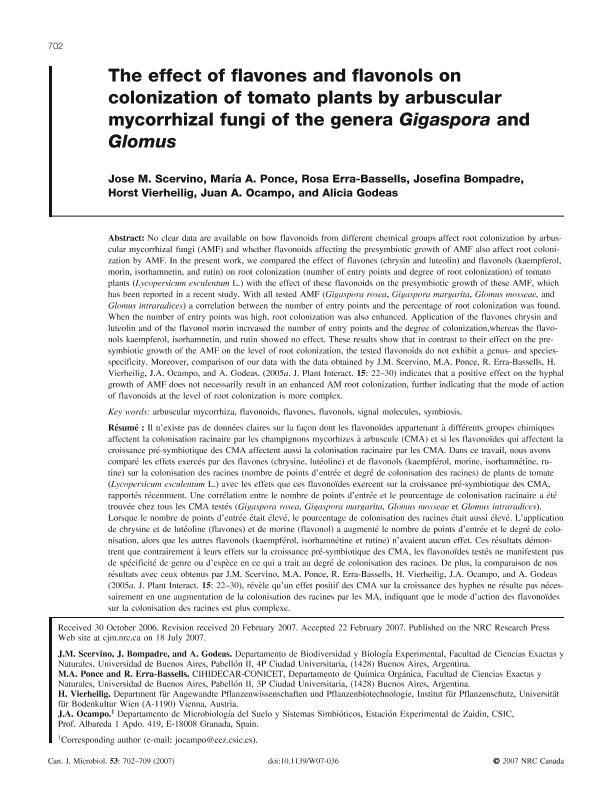Artículo
The effect of flavones and flavonols on colonization of tomato plants by arbuscular mycorrhizal fungi of the genera Gigaspora and Glomus
Scervino, Jose Martin ; Ponce, María Alejandra; Erra Bassells, Rosa; Bompadre, Maria Josefina
; Ponce, María Alejandra; Erra Bassells, Rosa; Bompadre, Maria Josefina ; Vierheilig, Horst; Ocampo, Juan A.; Godeas, Alicia Margarita
; Vierheilig, Horst; Ocampo, Juan A.; Godeas, Alicia Margarita
 ; Ponce, María Alejandra; Erra Bassells, Rosa; Bompadre, Maria Josefina
; Ponce, María Alejandra; Erra Bassells, Rosa; Bompadre, Maria Josefina ; Vierheilig, Horst; Ocampo, Juan A.; Godeas, Alicia Margarita
; Vierheilig, Horst; Ocampo, Juan A.; Godeas, Alicia Margarita
Fecha de publicación:
06/2007
Editorial:
National Research Council Canada-NRC Research Press
Revista:
Canadian Journal Of Microbiology
ISSN:
0008-4166
Idioma:
Inglés
Tipo de recurso:
Artículo publicado
Clasificación temática:
Resumen
No clear data are available on how flavonoids from different chemical groups affect root colonization by arbuscular mycorrhizal fungi (AMF) and whether flavonoids affecting the presymbiotic growth of AMF also affect root colonization by AMF. In the present work, we compared the effect of flavones (chrysin and luteolin) and flavonols (kaempferol, morin, isorhamnetin, and rutin) on root colonization (number of entry points and degree of root colonization) of tomato plants (Lycopersicum esculentum L.) with the effect of these flavonoids on the presymbiotic growth of these AMF, which has been reported in a recent study. With all tested AMF (Gigaspora rosea, Gigaspora margarita, Glomus mosseae, and Glomus intraradices) a correlation between the number of entry points and the percentage of root colonization was found. When the number of entry points was high, root colonization was also enhanced. Application of the flavones chrysin and luteolin and of the flavonol morin increased the number of entry points and the degree of colonization,whereas the flavonols kaempferol, isorhamnetin, and rutin showed no effect. These results show that in contrast to their effect on the presymbiotic growth of the AMF on the level of root colonization, the tested flavonoids do not exhibit a genus- and species-specificity. Moreover, comparison of our data with the data obtained by J.M. Scervino, M.A. Ponce, R. Erra-Bassells, H. Vierheilig, J.A. Ocampo, and A. Godeas. (2005a. J. Plant Interact. 15: 22-30) indicates that a positive effect on the hyphal growth of AMF does not necessarily result in an enhanced AM root colonization, further indicating that the mode of action of flavonoids at the level of root colonization is more complex.
Palabras clave:
ARBUSCULAR MYCORRHIZA
,
FLAVONES
,
FLAVONOIDS
,
FLAVONOLS
,
SIGNAL MOLECULES
,
SYMBIOSIS
Archivos asociados
Licencia
Identificadores
Colecciones
Articulos(CIHIDECAR)
Articulos de CENTRO DE INVESTIGACIONES EN HIDRATOS DE CARBONO
Articulos de CENTRO DE INVESTIGACIONES EN HIDRATOS DE CARBONO
Articulos(INBA)
Articulos de INST.DE INVEST. EN BIOCIENCIAS AGRICOLAS Y AMBIENTALES
Articulos de INST.DE INVEST. EN BIOCIENCIAS AGRICOLAS Y AMBIENTALES
Citación
Scervino, Jose Martin; Ponce, María Alejandra; Erra Bassells, Rosa; Bompadre, Maria Josefina; Vierheilig, Horst; et al.; The effect of flavones and flavonols on colonization of tomato plants by arbuscular mycorrhizal fungi of the genera Gigaspora and Glomus; National Research Council Canada-NRC Research Press; Canadian Journal Of Microbiology; 53; 6; 6-2007; 702-709
Compartir
Altmétricas



